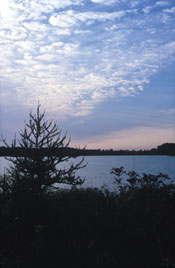Main Content
Article
About Natural Areas
Most of Indiana’s natural areas were destroyed before anyone had a chance to study them or try to understand them. As a result, we have lost the opportunity to learn about these areas and the benefits and opportunities they might have yielded.

Olin Lake,
photo by Lee Casebere
Today our remaining natural areas serve important roles in the study of a number of areas, including:
- Ecology
- Botany
- Zoology
- Geology
- Soil science
Natural areas provide controls for:
- Comparison against managed or exploited resources
- Useful educational and cultural information important in the study of science
- Local history
Conservation and nature studies such as:
- Birdwatching
- Insect study
- Wildflower and tree identification
- Examples of some of Indiana's rarest resources
PRESERVATION OF NATURAL AREAS
Preservation of natural areas also provides many practical benefits. For example, natural areas contain the biological raw material necessary for the development of products that could greatly benefit the health, diversity and genetic well-being of man. A new wonder drug or fine industrial product, yet to be discovered, may now exist only in some inconspicuous organism harbored in a nature preserve.
Already approximately half of the drugs currently in use contain derivatives of wild plants, yet only a small percentage of all plants have been investigated for their potential in such uses. The need to protect the remaining 98 percent until they can be researched is obvious.
From a genealogical standpoint, we all have roots linking us to our ancestors. With so many of our natural areas now gone, those that remain are a vital link to the past - the roots of our natural heritage. They can help us and future generations better understand the landscape and natural resources from which the pioneers molded their lives, and they us the ‘original Indiana’ that was here when they arrived 200 years ago.
BENEFITS TO SAVING NATURAL AREAS
Certainly, one of the most important benefits to be derived from natural areas is the recreational benefit they provide. This is evidenced by the increasing numbers of people who turn to our parks, forests and nature preserves in order to escape the hustle-bustle of our fast paced society. The quiet enjoyment of nature soothes the monotony in our daily lives whether from skyscrapers and pavement or unbroken horizons of corn and beans.
Healthy natural areas can offer substantial economic benefits to our communities, as well. Wetlands, for example, help with flood protection and the removal of pollutants from our water supply. A helpful and more detailed resource about the economic benefits of wetlands has been created by the EPA:
In 2010, Governor Daniels announced the Healthy Rivers INitiative in acknowledgement of the importance to help protect and restore our state's precious water habitats.
